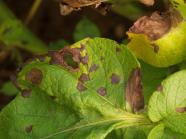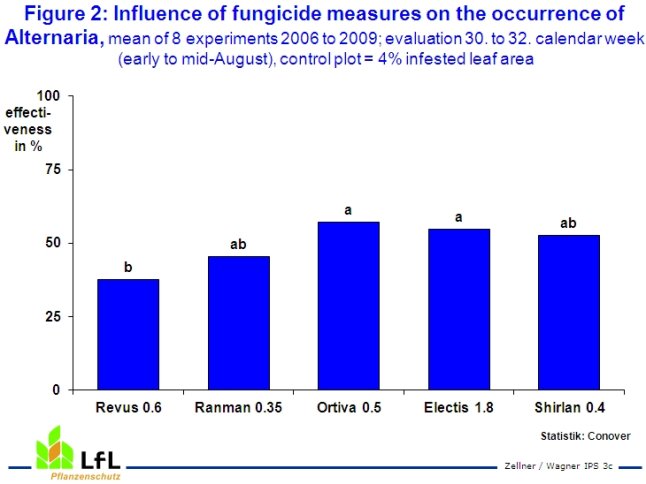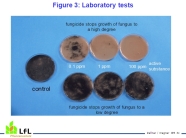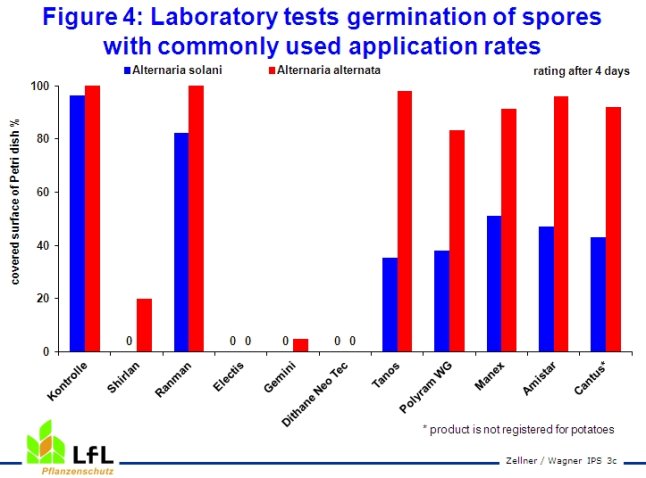
Effects of Fungicides on Alternaria solani and Alternaria alternata

Alternaria - leaf spots
Already at the beginning of June first spots caused by Alternaria can appear on the lower, shaded leaves. Especially with drought and/or heat stress as well as too high soil moisture the fungi spread to the rest of the leaves. The source of infection primarily is potato tops from the previous year. But also weeds and ill potato seed tubers can be the origin of this fungal disease.
The symptoms on potatoes are caused by two different kinds of Alternaria: Infestation with Alternaria solani (early blight) causes clearly defined, angled to round spots (up to 2 cm) with concentric rings and with Alternaria alternata (leaf blight) numerous small spots (up to 0.5 cm) appear on the leaves.Little effect in field trials
This potato disease can be found in all potato growing countries. Throughout Bavaria a monitoring of 54 potato fields, which showed an unnaturally quick maturation of potato tops, was realized in 2001. Infestation of leaves and stems with fungal diseases was examined. As shown in figure 1 besides pathogens of Colletotrichum, Fusarium and Verticillium also Alternaria was found very often. For this reason late blight fungicides were tested for their side effect on Alternaria spp. at two different sites over the past years. In order to keep the infestation rate of late blight low the whole test field (including the control plot) was treated on a weekly basis with fungicides which have an effect on this disease only. The interval between sprayings against Alternaria was 7 to 10 days. The first treatment was carried out before any symptoms occurred. As shown in the rating results all tested fungicides reduced Alternaria infestation compared to the control plot. Statistically significant differences of the effect on Alternaria can only be shown for Ortiva and Electis in opposition to Revus (figure 2).
figure 1 and 2
| administrative district | Number of samples | Alternaria spp. | Colletotrichum | Verticillium | Fusarium |
|---|---|---|---|---|---|
| Central franconia | 2 | 100 | 100 | 100 | |
| Lower Bavaria | 13 | 92 | 69 | 8 | 38 |
| Upper Bavaria north | 10 | 100 | 70 | 70 | |
| Upper Bavaria south | 10 | 100 | 90 | 70 | |
| Upper Franconia | 2 | 50 | 100 | ||
| Upper Palatinate | 9 | 100 | 89 | 67 | |
| Swabia | 6 | 83 | 100 | 33 | 33 |
| Lower Franconia | 2 | 50 | 100 | ||
| Bavaria | 54 | 93 | 83 | 6 | 54 |

In laboratory tests differences are present
 Zoombild vorhanden
Zoombild vorhanden
Figure 3: Laboratory tests
In another experiment the effect of different products on Alternaria was examined in laboratory tests. For this purpose fungicides were mixed with agar-culture medium and 100 ml spore suspension (concentration 104 spores/ml) was spread on the agar (figure 3). Laboratory analyses were preformed separately with Alternaria solani and A. alternata. After 4 days the fungus covered surface was evaluated. In this test Dithane Neo Tec, Electis, Gemini and Shirlan stopped the growth of the fungus to a good extent for both varieties of Alternaria. The products Tanos, Polyram WG, Manex, Amistar and Cantus (not registered for potatoes at present) showed an effect to some extent on A. solani and a low/no effect on A. alternata. Ranman had no effect on either variety.
Don’t overestimate Alternaria diseases
The different results in field and laboratory tests indicate that both pathogens can only infest leaf and stem tissue to a greater extent if the plant was exposed to physiological stress beforehand. This includes heat and drought, shading, nutrient deficiency and high soil moisture over a longer period. Our monitoring results (figure 1) allow to conclude that an infestation with other pathogens, as Colletotrichum coccodes, Verticilium spp. or Fusarium oxysporum, considerably increases the susceptibility to Alternaria. Accordingly the Alternaria varieties are to be regarded as weakness parasites with a low damage effect under our climatic conditions. This is the only possibility to explain why Ranman achieved the best results in field trials (figure 2), in Alternaria rating as well as in crop yield, although the product didn’t show any repressive effect in the laboratory tests (figure 4 and 5). The diseases mentioned above are much more relevant for an unnaturally early maturation of potato tops than Alternaria is. For this reason further studies should clarify to which extent fungal diseases interact in their degree of damage.
Conclusion
The results presented in this article show that, with the products available, there is no promising fungicide strategy against Alternaria. At present an Alternaria infestation can be best prevented by choosing potato varieties which respond less to heat and drought by unnaturally early maturation.




